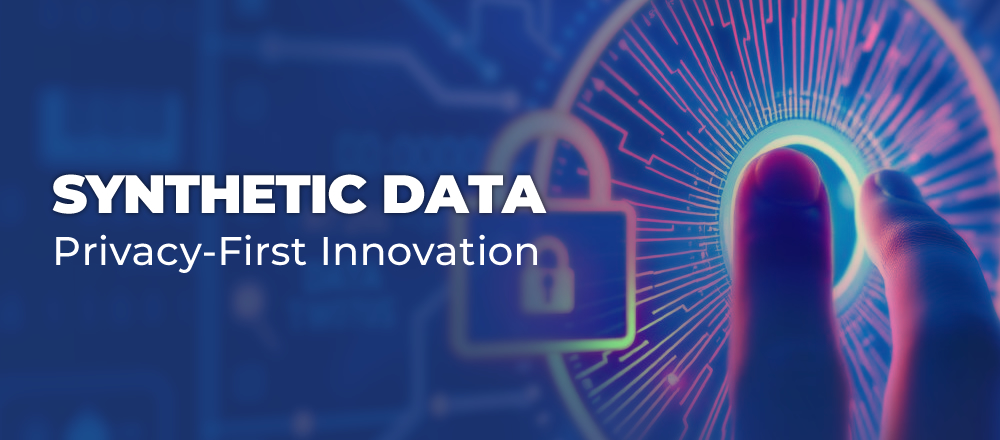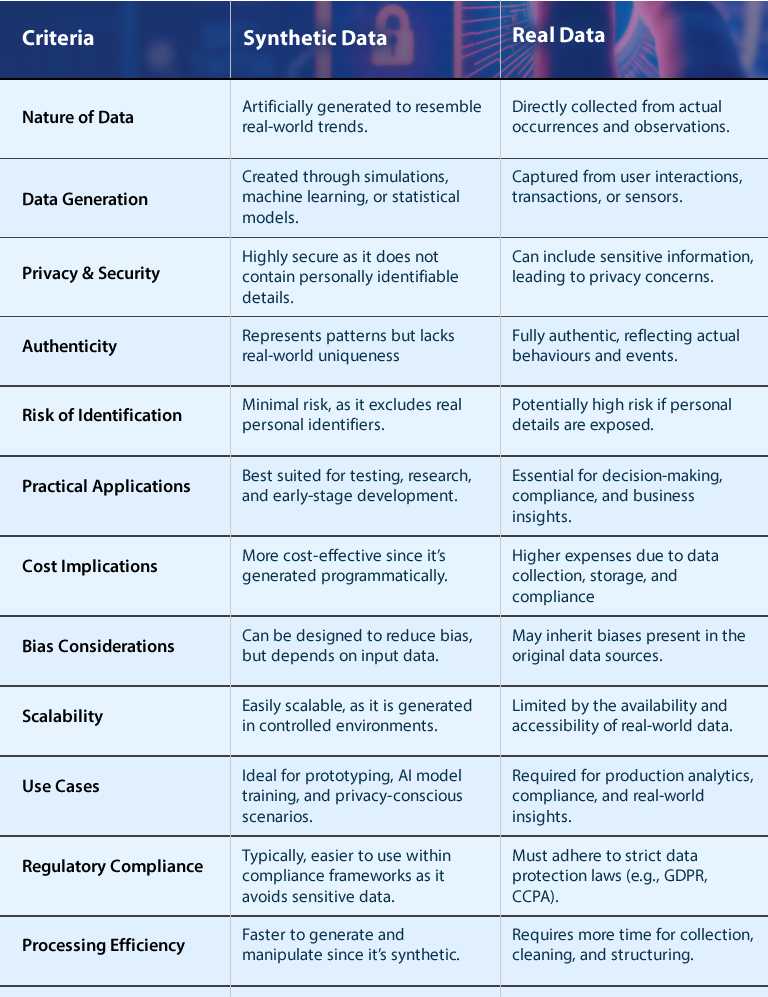Imagine teaching a self-driving car to navigate a city it has never seen before without ever putting it on the road, or training a fraud detection system without exposing it to real financial transactions. The need for high-quality, representative data is undeniable today! Yet real-world data often comes with challenges—scarcity, bias, privacy concerns, or sheer inaccessibility. This is where synthetic data steps in!

Synthetic data, as the name suggests, is artificially generated data that mimics the statistical properties of real data. It’s not real data about real individuals, but it’s crafted to be realistic enough to train AI models and perform analyses without compromising privacy. Think of it as creating a digital twin of your data, that’s safe to share and experiment with.
But how can artificially generated data be as good as—or even better than—the real thing? Let’s dive in.
How Does Synthetic Data Differ from Real Data?
While both real and synthetic data can be used for analysis and model training, their creation, characteristics, and suitability differ significantly for various applications. The following table outlines these key differences.

How Do We Create Synthetic Data?
Creating effective synthetic data is a complex process that involves several sophisticated techniques. Here are a few key approaches:
Statistical Methods
These methods focus on capturing the statistical distributions and correlations within the real data. Techniques like generating random samples from fitted distributions, using copulas to model dependencies, and creating Markov chains to simulate sequential data fall under this category. These methods are often simpler to implement but might struggle with capturing complex non-linear relationships.
Machine Learning-Based Methods
More advanced techniques leverage the power of machine learning to learn the underlying patterns in real data and generate synthetic data that closely resembles it. Generative Adversarial Networks (GANs) and Variational Autoencoders (VAEs) are popular examples. GANs, in particular, pit two neural networks against each other – a generator that creates synthetic data and a discriminator that tries to distinguish between real and synthetic data – leading to increasingly realistic synthetic datasets. For example, researchers have used GANs to generate synthetic medical images for training diagnostic models.
Agent-Based Modeling
This approach is particularly useful for simulating complex systems with interacting entities. Agents are programmed with specific behaviours and rules, and their interactions generate synthetic data that reflects the dynamics of the real-world system. This is often used in areas like finance and healthcare. For example, agent-based models have been used to simulate the spread of infectious diseases and evaluate the effectiveness of different intervention strategies.
Privacy-Preserving Techniques
Techniques like differential privacy can be incorporated into the synthetic data generation process to further enhance privacy. Differential privacy adds carefully calibrated noise to the data, making it difficult to re-identify individuals while preserving the overall statistical properties. For instance, differential privacy has been used by the US Census Bureau to release data products while protecting the privacy of individual respondents.
Interested in exploring synthetic data solutions for your business?
Contact us today for a consultation.
Business Benefits of Synthetic Data
While privacy is a major driver for synthetic data adoption, the benefits extend far beyond. Some of the business benefits of synthetic data are:
Data Accessibility
Synthetic data removes the regulatory hurdles and privacy concerns associated with using real data, making it easier to share and collaborate on data-driven projects. This is especially important in regulated industries like healthcare and finance.
Cost Reduction
Acquiring and labelling real data can be expensive and time-consuming. Synthetic data offers a cost-effective alternative, allowing organizations to train models and conduct analyses without breaking the bank.
Improved Model Performance
In some cases, synthetic data can improve model performance. For example, if the real data is imbalanced or contains biases, synthetic data can be used to augment the dataset and create a more balanced and representative training set.
Faster Development Cycles
With readily available synthetic data, development teams can iterate faster and experiment with different models without waiting for real data to be collected and processed.
Scenario Planning and Simulation
Synthetic data can be used to simulate different scenarios and test the robustness of models in various situations. This is particularly valuable for risk assessment and strategic planning.
Synthetic Data is Not Always Perfect
While synthetic data holds immense potential, it’s not a silver bullet. Key challenges often posed by synthetic data are:
- Fidelity: Ensuring that the synthetic data accurately captures the complex relationships in the real data is crucial. If the synthetic data is too simplistic, models trained on it might not generalize well to real-world scenarios.
- Bias Amplification: If the real data contains biases, the synthetic data might inherit and even amplify those biases. Care must be taken to identify and mitigate biases during the data generation process.
- Evaluation: Evaluating the quality and usefulness of synthetic data can be challenging. Traditional metrics might not be applicable, and new evaluation methods are needed.
The Future of Synthetic Data
The field of synthetic data is rapidly evolving, with new techniques and tools being developed constantly. As machine learning models become more sophisticated and our understanding of privacy-preserving techniques deepens, synthetic data will play an increasingly important role in enabling data-driven innovation across various industries. It represents a powerful tool for balancing the need for data with the imperative to protect privacy, paving the way for a future where data can be used responsibly and ethically to unlock its full potential.
Evaluating the quality and usefulness of synthetic data can be challenging. At Helios Solutions, we understand these challenges and have developed robust methodologies for synthetic data creation and validation. We can help you overcome the hurdles of data scarcity, privacy concerns, and model bias. Let’s discuss your specific needs.

